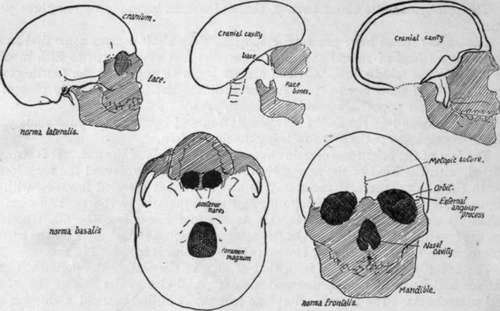Chapter VI. Skull And Hyoid
Description
This section is from the book "The Anatomy Of The Human Skeleton", by J. Ernest Frazer. Also available from Amazon: The anatomy of the human skeleton.
Chapter VI. Skull And Hyoid
The skull can be divided for descriptive purposes into a facial and a cranial part. The cranial bones form the warls of the cavity that contains the brain, and the face bones are situated below the front portion of this " brain-box".
Looking at the skull from the side, or in sagittal section, we obtain a general idea of this relationship (Fig. 158) : the cranial cavity is seen to be deepest behind, with its floor or base sloping upwards and forwards on the whole, and the space below it obtained in this way is occupied by the bones of the face. Looking at it from below, the face bones hide the front part of the cranial region, which is only visible behind them. From the front the cranial portion of the skull is above, the facial part below, and the cavities of the orbits are seen to lie between the two parts : the nasal cavities are placed between the two halves of the face, and the opening of the mouth passes transversely across it, separating the upper from the lower portion or mandible.
For practical descriptive purposes the division into cranial and facial bones is useful, but, as we will see later, it is not effected on morphological grounds, and, like most purely descriptive classifications, it therefore cannot be pushed to include every detail, or even every skull bone, in its scope.

Fig. 158..-The shaded portion of each figure indicates the facial skeleton. In the upper central figure a scheme of the general construction of the skull is seen ; the cranial part has a floor sloping up in front and the face bones are placed below the raised front portion. The whole is supported on the spine by articulation on the cranium. Pterygoid processes hang down from the cranial base behind the face bones ; these are seen in the upper right figure of sagittal section also, but here the lower jaw is in place showing that the face bones extend round on each side of the region of pterygoid plates, while the remainder of the face lies in front of them. Other drawings are from the side, base and front.
A cursory examination of the skull reveals the fact that it is composed of several bones which, with the exception of the lower jaw, are immovably articulated with each other. This is most apparent when the complete skull is viewed from above (norma verticalis) or from the side (norma lateralis), when the several bones are seen at once articulating with each other along irregular lines, known as sutures*
Before proceeding to a detailed examination of these bones and of the complete skull it is advisable to become acquainted with the relative positions of the bones in the skull.
Continue to:
